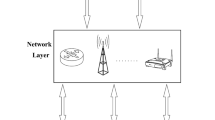Abstract
Radio frequency identification (RFID) is a technology with numerous benefits in applications where objects have to be identified automatically. However, cost, fragile tags, collision and reading errors are some of issues to be concerned with in an RFID implementation. Mainly, this paper proposes a method for tag identification and a method for the selection of the binary codes to program on the tags in order to facilitate the identification process. For the identification method a heuristic based on Hamming distance is developed where the basic idea is to utilize the information obtained in consecutive read attempts to help identify a tag. For the selection method three models based on Hamming distance are also developed which strive to find the set with the greatest dissimilarity among the codes. Computer simulations are performed to verify the validity of the proposed methods.





Similar content being viewed by others
References
Chan HL, Choi TM, Hui CL (2012) RFID versus bar-coding systems: transactions errors in health care apparel inventory control. Decis Support Syst 54(1):803–811
Chang S, Klabjan D, Vossen T (2010) Optimal radio frequency identification deployment in a supply chain network. Int J Prod Econ 125(1):71–83
Doerr KH, Gates WR, Mutty JE (2006) A hybrid approach to the valuation of RFID/MEMS technology applied to ordnance inventory. Int J Prod Econ 103(2):726–741
García A, Chang YS, Valverde R (2006) Impact of new identification and tracking technologies on a distribution center. Comput Ind Eng 51(3):542–552
Huang C-T, Lo L-W, Wang W, Chen H-L (2008) A study for Optimizing the reading rate of RFID tagged cartons in Palletizaing Process. In: Proceeding of IEEE international conference on industrial engineering and engineering management, IEEM, Singapore, 1138–1142
Inoue S, Hagiwara D, Yasuura H (2006) Systematic error detection for RFID reliability. In: Proceedings of the 1st intenational conference of avaliability, reliability and security, IEEE Computer Society, Vienna, pp 1–5
Irani Z, Gunasekaran A, Dwivedi Y (2010) Radio frequency identification (RFID): research trends and framework. Int J Prod Res 48(9):2485
Jo YY, Cho SH, Jeon KY (2007) An error correction method to improve the tag identification of UHF RFID System. In: Proceedings of the 1st RFID annual conference euroasia, IEEE Computer Society, Istambul, pp 1–4
Kok AG, Donselaar KH, Woensel T (2008) A break-even analysis of RFID technology for inventory sensitive to shrinkage. Int J Prod Econ 112(2):521–531
Lee I, Lee B (2010) An investment evaluation of supply chain RFID technologies: a normative modeling approach. Int J Prod Econ 125(2):313–323
Lin LC (2009) An integrated framework for the development of radio frequency identification technology in the logistics and supply chain management. Comput Ind Eng 57(3):832–842
Liu X, Tang O, Huang P (2008) Dynamic pricing and ordering decision for the perishable food of the supermarket using RFID technology. Asia Pac J Mark Logist 20(1):7–22
Lu MT, Lin SW, Tzeng GH (2013) Improving RFID adoption in Taiwan’s healthcare industry based on a DEMATEL technique with a hybrid MCDM model. Decis Support Syst 56(1):259–269
Mourtzis D, Papakostas N, Makris S, Xanthakis V, Chryssolouris G (2008) Supply chain modeling and control for producing highly customized products. CIRP Ann 57(1):451–454
Ngai EWT, Moon KKL, Riggins FJ, Candance YY (2008) RFID research: an academic literature review (1995–2005) and future research directions. Int J Prod Econ 112(2):510–520
Pei J, Klabjan D (2010) Inventory control in serial systems under radio frequency identification. Int J Prod Econ 123(1):118–136
Porter JD, Billo RE, Mickle MH (2004) A standard test protocol for evaluation of radio frequency identification systems for supply chain applications. J Manuf Syst 23(1):46–55
Potdar V, Hayati P, Elizabeth C (2007) Improving RFID read rate reliability by a systematic error detection approach. In: Proceedings of the 1st RFID annual conference euroasia, IEEE Computer Society, Istanbul, pp 1–5
Rekik Y, Sahin E, Dallery Y (2008) Analysis of the impact of the RFID technology on reducing product misplacement errors at retail stores. Int J Prod Econ 112(1):264–278
Rekik Y, Sahin E, Dallery Y (2009) Inventory inaccuracy in retail stores due to theft: an analysis of the benefits of RFID. Int J Prod Econ 118(1):189–198
Rekik Y (2011) Inventory inaccuracies in the wholesale supply chain. Int J Prod Econ 133(1):172–181
Sarac A, Absi N, Dauzère-Pérès S (2010) A literature review on the impact of RFID technologies on supply chain management. Int J Prod Econ 128(1):77–95
Tu Y-J, Piramuthu S (2008) Reducing false reads in RFID-embedded supply chains. J Theor Appl Electron Commer Res 3:60–70
Ukkoken L, Engels D, Sydanheimo A, Kivikoski M (2005) Reliability of passive RFID of multiple objects using folded microstrip patch-type tag antenna. In: Proceedings of the IIE international symposium of antennas and propagation society, IEEE Computer Society, Washington DC, pp 341–344
Wang SJ, Liu SF, Wang WL (2008) The simulated impact of RFID-enabled supply chain on pull-based inventory replenishment in TFT-LCD industry. Int J Prod Econ 112(2):570–586
Wang C, Li B, Daneshmand M, Sohraby K, Jana R (2010) On object identification reliability using RFID. Mob Netw Appl 16:71–80
Zhou W, Yoon EJ, Piramuthu S (2012) Simultaneous multi-level RFID tag ownership & transfer in health care environments. Decis Support Syst 54(1):98–108
Acknowledgments
This research was supported by the Tecnológico de Monterrey Research Group in Industrial Engineering and Numerical Methods 0822B01006.
Author information
Authors and Affiliations
Corresponding author
Rights and permissions
About this article
Cite this article
Hervert-Escobar, L., Smith, N.R., Rodríguez-Cruz, J.R. et al. Methods of selection and identification of RFID tags. Int. J. Mach. Learn. & Cyber. 6, 847–857 (2015). https://doi.org/10.1007/s13042-015-0399-5
Received:
Accepted:
Published:
Issue Date:
DOI: https://doi.org/10.1007/s13042-015-0399-5




